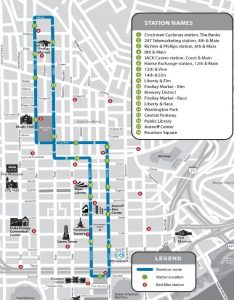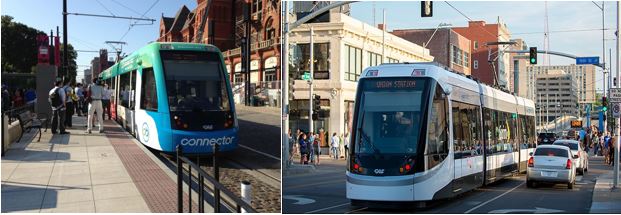Kansas City, Missouri and Cincinnati, Ohio are two similar sized working class cities. Over the past twenty years, advocates and opponents have argued for or against the rebuilding of their forgotten streetcar networks. The two cities have faced similar problems throughout their urban centers. Suburbanization from the 1960’s to the 1990’s caused an outflow of population from central cities to the hinterlands we call suburbs. With this, jobs also followed creating a giant hole in the urban fabric of both cities.
Over the years, downtown Kansas City became a 9-5 neighborhood only supporting those who still commuted in for work. Beyond business hours however, the city core would shut down and stores closed. Cincinnati also faced similar problems that caused its downtown to go by the way side. By the 1990’s both cities were in dyer need of revitalization.
In the early to mid 2000’s Kansas City and Cincinnati had begun construction of large mixed use projects in their downtown’s. Both projects were anchored by public space, commercial businesses and arenas or sports stadiums. These two newly formed portions of both downtown’s were prime real estate for a streetcar to pass through. By this point, streetcars were being planned to navigate the downtown streets of both places. Fast forward to 2017 and both streetcar lines have been built and are operational.
Kansas City, a 2.2 mile down and back system runs along Main Street from Union Station North to the River Market, where it loops around and heads back South, along the way passing by landmarks, attractions and shopping. Cincinnati Streetcar is a 3.6 mile figure eight design running through the city’s core. It too connects various landmarks, attractions and shopping. Both cities also use the exact same model of streetcar trains. Business owners and residents of the corridors have seen the economic impact on there properties as a benefit. When it comes to funding both Streetcar lines, The Bell Connector and KC Streetcar had a combination of sources for funding. A mixture of federal grants and local funds set up through Tax Increment Funding (TIF), property tax, income tax… supported the construction and cost of both lines.
Some of the differences between either city’s streetcar systems can be found in the a few ways. Cincinnati’s streetcar has a fare for riders, Kansas City’s is free. This was done by Kansas City voting to set up a new taxing district 1/3 mile in either direction of the line to help pay for its costs. The idea was that if property owners pay into this amenity their return in customer traffic and spending will exceed the cost. Instead of the entire city funding what really has a small geographic scale of economic impact in downtown Kansas City, only those who would potentially benefit the most would pay into it. When it comes to ridership, the Kansas City Streetcar has outperformed the Cincinnati Bell Connector. On average, daily ridership still remains above the expectations of Kansas City leaders and advocates. Weekends are the most busy sometimes hitting 13,000 – 15,000 riders per day. These numbers have remained fairly consistent since last May 2016 when it opened (Ridership). The Cincinnati project has not had as much consistent success. Its ridership numbers began plummeting unfortunately due to what is thought to be three main causes(Coolidge).
1. Ticket voucher machines were not user friendly. 2. Real-time arrival updates were not working properly 3. Cincinnati’s downtown was in desperate need of a traffic study
Here are some other facts:
Cost
- KC Streetcar– $102 mil (On budget) $25 mil per mile (Including replacement of water and sewer infrastructure) (Horsley)
- Cincinnati Streetcar– $148 mil ($40 million over budget) $36 mil per mile (Williams)
Average Daily Ridership (November 2016)
- KC Streetcar – 4,500 per day (Day)
- Cincinnati Streetcar– 1,651 per day (Coolidge)
Number of Stops
- Cincinnati Streetcar– 18(Cincinnati)
- KC Streetcar– 16(Ridership)
Length
- Cincinnati Streetcar– 3.6 miles
- KC Streetcar– 2.2 miles
Cincinnati Route KC Route


“Cincinnati Bell Connector.” Home – City of Cincinnati. N.p., n.d. Web. 12 Mar. 2017.
Coolidge, Sharon. “Streetcar Ridership Numbers Way Short of Projections.” Cincinnati.com. USA Today, 06 Dec. 2016. Web. 12 Mar. 2017.
Day, and Daily Counts. “Total Ridership By Date.” KC STREETCAR RIDERSHIP (2017): n. pag. Ridekc.org. Web. 12 Mar. 2017.
HORSLEYlhorsley@kcstar.com, LYNN. “Kansas City Streetcar Costs Are Comparable to Other Cities.” Kansascity. Kansas City Star, 2 July 2015. Web. 12 Mar. 2017.
“Ridership.” KC Streetcar. Ride KC, n.d. Web. 12 Mar. 2017.
Williams, Jason. “Taxpayers on Hook for $15M Streetcar Cost.” Cincinnati.com. USA Today, 25 Nov. 2015. Web. 12 Mar. 2017.
